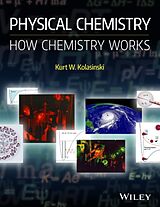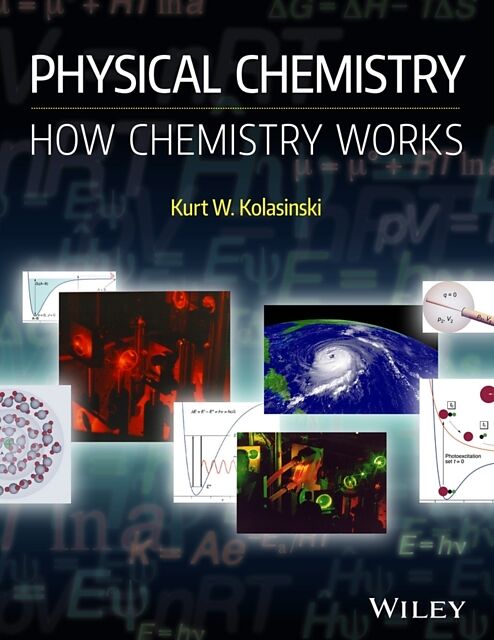Physical Chemistry
Einband:
Kartonierter Einband
EAN:
9781118751121
Untertitel:
How Chemistry Works
Genre:
Chemie
Autor:
Kolasinski Kurt W.
Herausgeber:
Wiley John + Sons
Auflage:
1. Auflage
Anzahl Seiten:
752
Erscheinungsdatum:
11.11.2016
ISBN:
978-1-118-75112-1
In der Chemie geht es überwiegend um die Frage: Wie? Wie wird primärer Alkohol hergestellt? Durch Reaktion eines Grignard-Reagenz mit Formaldehyd. In der physikalischen Chemie lautet die Frage: Warum? Das Grignard-Reagenz und Formaldehyd tanzen auf Molekülebene. Man spricht von einem Reaktionsmechanismus, bei dem stärkere Verbindungen schwächere Verbindungen vom Parkett fegen. Wenn Sie wissen möchten, warum das so ist, ist dieses Buch genau richtig.
Physical Chemistry: How Chemistry Works verfolgt einen neuen Ansatz bei der Vermittlung der Lerninhalte rund um die physikalische Chemie. Dieses moderne Lehrbuch soll Chemiestudenten im Hauptstudium für das Fachgebiet begeistern und auf die Anwendung der physikalischen Chemie in der Praxis vorbereiten. Praxisorientiert, leserfreundlich und modern sind die Beispiele, mit denen sich die physikalisch-chemischen Aspekte jedes Systems besser verstehen lassen. Studenten der anorganischen Chemie, organischen Chemie, analytischen Chemie und Biochemie erfahren alles Wissenswerte über die physikalische Chemie und wissen im Anschluss, was Synthesen, intermolekularen Wechselwirkungen und Materialeigenschaften sind. Studenten, die sich eingehender mit der physikalischen Chemie beschäftigen möchten, erleichtert dieses Lehrbuch diesen Schritt, denn es zeigt auch die Grenzen der Forschung auf.
Autorentext
Professor Kurt W. Kolasinski, West Chester University, Pennsylvania, USA Kurt Kolasinski has been an Associate Professor of physical chemistry at West Chester University since 2011 having joined the faculty in 2006. He has held faculty positions at the University of Virginia (2004 - 2006), Queen Mary University of London (2001-2004), and the University of Birmingham (UK) (1995 - 2001). His research focuses on surface science, laser/surface interactions and nanoscience. A particular area of expertise is the formation of nanostructures in silicon and porous silicon using a variety of chemical and laser-based techniques. He is the author of over 90 scholarly publications as well as the widely used textbook Surface Science: Foundations of Catalysis and Nanoscience, which appeared in its third edition in 2012.
Klappentext
Much of chemistry is motivated by asking 'How'? How do I make a primary alcohol? React a Grignard reagent with formaldehyde. Physical chemistry is motivated by asking 'Why'? The Grignard reagent and formaldehyde follow a molecular dance known as a reaction mechanism in which stronger bonds are made at the expense of weaker bonds. If you are interested in asking 'why' and not just 'how', then you need to understand physical chemistry. Physical Chemistry: How Chemistry Works takes a fresh approach to teaching in physical chemistry. This modern textbook is designed to excite and engage undergraduate chemistry students and prepare them for how they will employ physical chemistry in real life. The student-friendly approach and practical, contemporary examples facilitate an understanding of the physical chemical aspects of any system, allowing students of inorganic chemistry, organic chemistry, analytical chemistry and biochemistry to be fluent in the essentials of physical chemistry in order to understand synthesis, intermolecular interactions and materials properties. For students who are deeply interested in the subject of physical chemistry, the textbook facilitates further study by connecting them to the frontiers of research. * Provides students with the physical and mathematical machinery to understand the physical chemical aspects of any system. * Integrates regular examples drawn from the literature, from contemporary issues and research, to engage students with relevant and illustrative details. * Important topics are introduced and returned to in later chapters: key concepts are reinforced and discussed in more depth as students acquire more tools. * Chapters begin with a preview of important concepts and conclude with a summary of important equations. * Each chapter includes worked examples and exercises: discussion questions, simple equation manipulation questions, and problem-solving exercises. * Accompanied by supplementary online material: worked examples for students and a solutions manual for instructors. * Written by an experienced instructor, researcher and author in physical chemistry, with a voice and perspective that is pedagogical and engaging.
Inhalt
Preface xv About the companion website xvii 1 Introduction 1 1.1 Atoms and molecules 1 1.2 Phases 2 1.3 Energy 3 1.4 Chemical reactions 4 1.5 Problem solving 5 1.6 Some conventions 7 Exercises 11 Further reading 14 2 Ideal gases 15 2.1 Ideal gas equation of state 16 2.2 Molecular degrees of freedom 18 2.3 Translational energy: Distribution and relation to pressure 21 2.4 Maxwell distribution of molecular speeds 23 2.5 Principle of equipartition of energy 24 2.6 Temperature and the zeroth law of thermodynamics 25 2.7 Mixtures of gases 27 2.8 Molecular collisions 27 Exercises 29 Further reading 30 3 Non-ideal gases and intermolecular interactions 31 3.1 Non-ideal behavior 31 3.2 Interactions of matter with matter 32 3.3 Intermolecular interactions 34 3.4 Real gases 39 3.5 Corresponding states 42 3.6 Supercritical fluids 43 Exercises 43 Further reading 44 4 Liquids, liquid crystals, and ionic liquids 45 4.1 Liquid formation 45 4.2 Properties of liquids 45 4.3 Intermolecular interaction in liquids 47 4.4 Structure of liquids 50 4.5 Internal energy and equation of state of a rigid sphere liquid 52 4.6 Concentration units 53 4.7 Diffusion 55 4.8 Viscosity 57 4.9 Migration 59 4.10 Interface formation 60 4.11 Liquid crystals 62 4.12 Ionic liquids 64 Exercises 66 Further reading 67 5 Solids, nanoparticles, and interfaces 68 5.1 Solid formation 68 5.2 Electronic structure of solids 70 5.3 Geometrical structure of solids 72 5.4 Interface formation 76 5.5 Glass formation 78 5.6 Clusters and nanoparticles 78 5.7 The carbon family: Diamond, graphite, graphene, fullerenes, and carbon nanotubes 80 5.8 Porous solids 83 5.9 Polymers and macromolecules 84 Exercises 86 Endnotes 86 Further reading 86 6 Statistical mechanics 87 6.1 The initial state of the universe 88 6.2 Microstates and macrostates of molecules 89 6.3 The connection of entropy to microstates 91 6.4 The constant alpha: Introducing the partition function 93 6.5 Using the partition function to derive thermodynamic functions 94 6.6 Distribution functions for gases 96 6.7 Quantum statistics for particle distributions 98 6.8 The Maxwell-Boltzmann speed distribution 102 6.9 Derivation of the ideal gas law 103 6.10 Deriving the Sackur-Tetrode equation for entropy of a monatomic gas 104 6.11 The partition function of a diatomic molecule 106 6.12 Contributions of each degree of freedom to thermodynamic functions 106 6.13 The total partition function and thermodynamic functions 111 6.14 Polyatomic molecules 113 Exercises 115 Endnotes 116 Further reading 116 7 First law of thermodynamics 117 7.1 Some definitions and fundamental concepts in thermodynamics 118 7.2 Laws of thermodynamics 118 7.3 Internal energy and the first law 119 7.4 Work 121 7.5 Intensive and extensive variables 123 7.6 Heat 124 7.7 Non-ideal behavior changes the work 125 7.8 Heat capacity 126 7.9 Temperature dependence of Cp 127 7.10 Internal energy change at constant volume 129 7.11 Enthalpy 130 7.12 Relationship between CV and Cp and partial differentials 131 7.13 Reversible adiabatic expansion/compression 133 Exercises 136 Endnotes 138 Further reading 138 8 Second law of thermodynamics 139 8.1 The second law of thermodynamics 140 8.2 Thermodynamics of a hurricane 141 8.3 Heat engines, refrigeration, and heat pumps 145 8.4 Definition of entropy 148 8.5 Calculating changes in entropy 150 8.6 Maxwell's relations 152 8.7 Calculating the natural direction of change 154 Exercises 157 Endnotes 159 Further reading 159 9 Third law of thermodynamics and temperature dependen…

Leider konnten wir für diesen Artikel keine Preise ermitteln ...
billigbuch.ch sucht jetzt für Sie die besten Angebote ...
Die aktuellen Verkaufspreise von 5 Onlineshops werden in Realtime abgefragt.
Sie können das gewünschte Produkt anschliessend direkt beim Anbieter Ihrer Wahl bestellen.
Loading...
Die aktuellen Verkaufspreise von 5 Onlineshops werden in Realtime abgefragt.
Sie können das gewünschte Produkt anschliessend direkt beim Anbieter Ihrer Wahl bestellen.
| # | Onlineshop | Preis CHF | Versand CHF | Total CHF | ||
|---|---|---|---|---|---|---|
| 1 | Seller | 0.00 | 0.00 | 0.00 |
